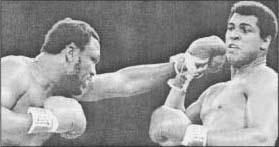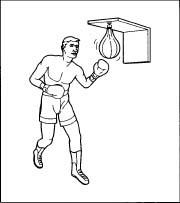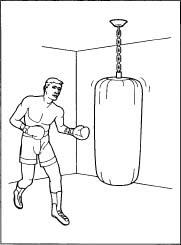Punching Bag
Background
A punching bag is a round or cylindrical piece of athletic equipment used by professional boxers for training and by amateurs for exercise. The bags come in a variety of sizes for a variety of uses. The largest, known as the heavy bag, is used to develop footwork and power. The timing bag, usually suspended from the ceiling and floor by bungee cords, develops timing and hand-eye coordination. The small speed bag develops hand speed, coordination, and rhythm.
History
The sport of boxing dates to the ancient Olympic Games. The first gold medal in boxing was awarded to a fighter named Onomastos in the twenty-third Olympiad. The earliest boxers were trained as if soldiers for war. There was little sophistication in the sport. Participants boxed bare-handed. One of the earliest boxers, Eurydamus, was known for his fierceness; he was reported to have swallowed his own teeth during a match rather than admit that he had been severely injured.
By the beginning of the first century A.D. , boxing had been forbidden and would not be seen again in the sports world until the eighteenth century in Great Britain. The first recorded English boxing champion was James Figg, who fought in the early part of the 1700s. Figg was followed by Jack Broughton in the mid century. Broughton was considered a master of blocking, parrying, and hitting on the retreat. In 1743, Broughton created a boxing code of conduct called the London Prize ring rules. (The rules were later revised and became known as the Revised London Prize Ring rules.) When Broughton's patron, the Duke of Cumberland, asked him to teach some of his well-to-do friends to box, Broughton devised special gloves, or mufflers, so that these "gentlemen" would not injure their hands.
The sport was further refined by the establishment of the Queensberry Rules, which were created under the sponsorship of another patron of the sport, John Sholto Douglas, the eighth marquess of Queensberry. These rules, still in effect today, set round limits, established glove weights, and created fighter classes by weight. They also forbade hits below the belt, to the back of the head, to the neck and to the kidneys.
It is not certain when the punching bag became part of the boxer's training regiment. The United States Office of Patents and Trademarks awarded a patent for the punching bag to Simon D. Kehoe in 1872. Since that time, others have made improvements to better simulate the human body.
With the increased interest in physical fitness and the advent of health clubs in the 1970s, amateurs became more interested in boxing as a form of fitness. By the beginning of the twentieth century, large numbers of people in the United States were enrolled in some type of boxing class.
Design
Paper patterns are created for the various panel sizes. The patterns are placed on sections of leather. Using chalk or grease pencils, a worker traces the shape of the pattern onto the leather.
A striking bag is usually constructed of two leather balloons, inserting one inside the other, then inflating the inner balloon with air to create a resilient ball.
Raw Materials
The earliest striking bags were made from kangaroo skin. However, goatskin is now more commonly used for small punching bags. The animal skin is dipped in strong chemicals to remove the hair prior to being cured in salt water. After curing, the skin is stretched and dried and ready for use in manufacturing.
The larger, heavy bags are constructed of polyvinyl or canvas. Canvas is a heavy cotton material. Polyvinyl is a plastic material developed during the Second World War. It is made from the byproducts of petroleum and coal.
A heavy, coated synthetic thread, typically nylon and polyester, is used to stitch the pieces of leather together.
While the striking bag is inflated with air, the heavy bags are filled with sand or finely shredded wood clippings.
Snaps, hooks, zippers, chainlink, and cord lacings are used to close the bags, attach them to the rebound board, and/or attach them to other bags.
The Manufacturing
Process
The manufacture of striking and training bags are accomplished through a combination of manual and mechanical steps.

Joe Frazier was born on January 17, 1944. Growing up in the rural South with his 12 brothers and sisters, Frazier rigged a punching bag from a burlap sack, rags, corncobs, brick, and Spanish moss. Leaving school at 14, he worked as a delivery man and then as a construction worker in South Carolina. Arriving in Philadelphia, he got a job at a slaughterhouse and developed a habit that would be immortalized in the movie Rocky: Frazier practiced his punches on hanging sides of beef.
Frazier's boxing career began in 1964 after wining the Olympic gold medal in Japan, and peaked when he became the first American Olympic heavyweight champion to also win the heavyweight title of the world. When he was champion, Frazier held the highest knockout percentage in history, and while he had been knocked down a few times, he had never been knocked out. Frazier was involved in "The Fight of the Century" with Muhammad Ali in 1971 for the world heavyweight title, which Frazier held. The Frazier-Ali fight was the first of three and set indoor boxing records for attendance and revenue.
Frazier underwent cataract surgery on his left eye in 1975. While the cataract was removed, it was too late—he was legally blind in his left eye and now wore contacts to fight. A rematch with George Foreman in June of 1976 was stopped in the fifth round, and Frazier knew his career was over. He came out of retirement in December of 1981 to fight Floyd Cummings. Even though the bout was a draw Frazier had to admit it was time to hang up the gloves for good.
Constructing the striking bag
- The leather for the bag is usually derived from goatskin. The skin must be tanned by placing it in rotating drums filled with a salt and water solution. The salt ingredient is typically chromium. In approximately eight hours, the chromium soaks through the skin. The chromium is then "fixed" to the skin by the addition of an alkaline chemical such as sodium carbonate or bicarbonate.
- The tanned skin is run through a machine that shaves it to the desired thickness. After that, it is passed through a wringer to remove excess moisture.
-
Once the leather has been dried and prepared, it is ready to be cut.
First, patterns that are the exact size and shape of each panel are
traced onto the leather using chalk or a grease pen. Then, these
sections are manually cut by workers using leather-cutting shears or
knives.
Some manufacturers employ automated cutting machines in order to create the panels. In these cases, a very sharp metal component is constructed in the exact size and shape of the panel. As the leather passes
under this metal die, the die cuts down into the fabric similar to a cookie cutter. A boxer practicing with a speed bag.
A boxer practicing with a speed bag. - The next step is to sew the leather panels together. The bags are constructed with either four or six panels, depending on the desired size. When sewn together, the panels create a pear-shaped balloon. Heavy duty nylon or polyester thread is used to stitch the pieces to one another. The stitching is performed by a worker operating a sewing machine.
- Once the two bags have been sewn together, the inner bag needs to be inflated with air. An inflation device called a collar is inserted into the inner bag just before the two bags are completely stitched. A valve on the inflation collar regulates the amount of air that is blown into the outer bag. Inflated air is measured in terms of pounds per square inch, or psi. The striking bag is inflated to a measure of 4—4.5 psi. A cap on the collar then clamps the bag wall to the collar skirt.
- The final step involves manually connecting the striking bag to an overhead rebound board by a piece of flexible metal combined with a ball-and-socket joint. The rebound board may be constructed of wood or a thick, durable plastic.
Constructing the training bag
- Training bags are usually made of vinyl or canvas. The vinyl or canvas is cut from patterns using a garment knife or die cutting machine, just as the leather was cut for a striking bag. The round top and bottom pieces are cut on a punch press.
- Once all of the material has been cut to the specified size, the pieces are sewn together. Again, strong nylon or polyester thread is used. The pieces are stitched together by a worker operating a sewing machine. The top is left open.
- In order to fill the bag, it is placed over a sleeve attached to a hopper. The stuffing materials, such as shredded wood clippings or sand, are loaded into the hopper. Forced air fills the bag with the stuffing materials.
- The top of the bag is sealed by sewing tabs of vinyl or canvas to the top edges of the bag. A round length of tubing, called a torus, is threaded through the tabs. Four metal rings, attached to four chains, are fitted around the torus. The top is then closed with laces or with zippers.
Quality Control
In order to ensure that bags have been properly constructed, manufacturers will periodically test the final product. Either manually or using automatic robotic devices, the bags undergo rigorous tests that determine the durability of the seams, the outer material, and the hanging components. To test the seams, the fabric may be pulled in opposing directions at measured forces or repeatedly tugged and timed. Punching the bag in a manner similar to how it will be used is also another quality control measure. It is important to ensure that the final product can withstand excessive wear and tear and that the primary components will remain in tact after use, especially considering the purpose of this product.
Byproducts/Waste
Scraps of leather, vinyl, canvas, thread, and fill material are the excess waste produced through the manufacture of punching bags. Depending on the size of the scrap fabrics, they will either be reused for other goods produced by the company or, more likely, disposed of in the trash. Any pieces of thread will also be thrown away. Fill material may be recollected for the same use if it is still in good condition. Excess wood clippings could be safely incinerated and sand can be disposed of at an appropriate dump site if not adequate for reuse.
The Future
Manufacturers continue to make improvements to punching bags in an effort to better simulate the human body and its reactions to strikes. A patent was issued in 1998 by the United States Trademark and Patent Office for a training apparatus that combined a head-sized striking bag to a hanging training bag.
Other innovations are designed to attract the amateur boxing enthusiast. One such version is the Soc-o-Mac, developed by Howard "Mack" McConnell in 1976. The Soc-o-Mac weighs about 450 lb (204 kg) and sits in a weighted steel pan on the floor. The steel pan's curved bottom keeps the bag upright and allows it to roll over and back up when hit.
In the early 1980s, Tom Critelli, a former deputy sheriff invented a water-filled bag that can be drained and refilled. Another invention in the last decade of the twentieth century, was the SoloSpar, an automated heavy bag that moves when punched and talks back when struck in certain spots.
Where to Learn More
Books
Carpenter, Harry. Boxing: A Pictorial History. Chicago: Henry Regnery, 1975.
Periodicals
Lidz, Franz. "A Fighter Would Have to be All Wet." Sports Illustrated (20 June 1983): 12.

McDonnell, Terry. "Punchline." The Business Journal (serving Phoenix and Valley of the Sun) (19 June 1989): 1.
Millman, Chad. "Automated Attitude." Sports Illustrated (21 February 1994): 89.
Other
"U.S. Patent 5142758: Punching Bag Construction and Suspension." Delphion Web Page. December 2001. < http://www.delphion.com >
"U.S. Patent 5769761: Striking Bag Training Apparatus." Delphion Web Page. December 2001. < http://www.delphion.com >.
Mary McNulty
Comment about this article, ask questions, or add new information about this topic: